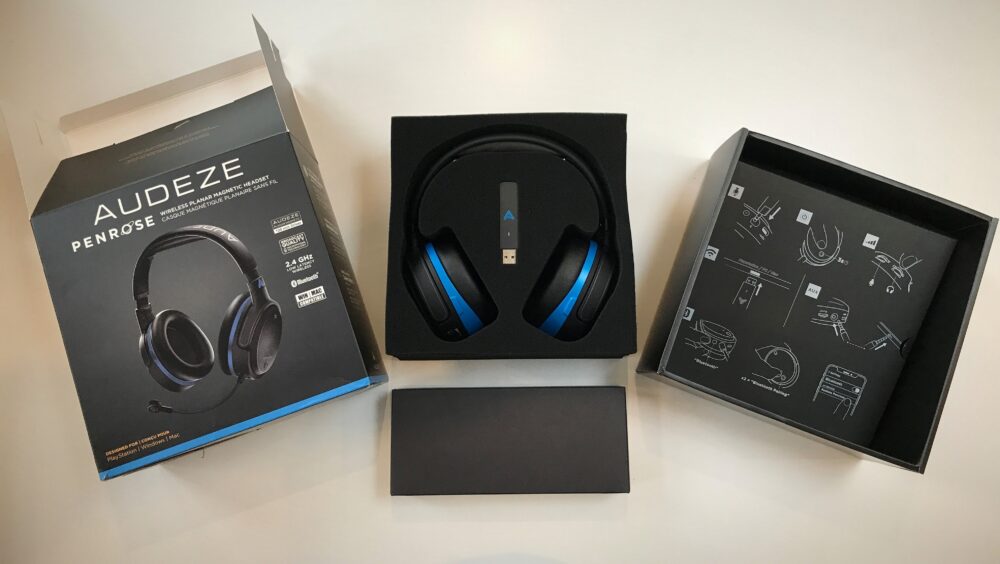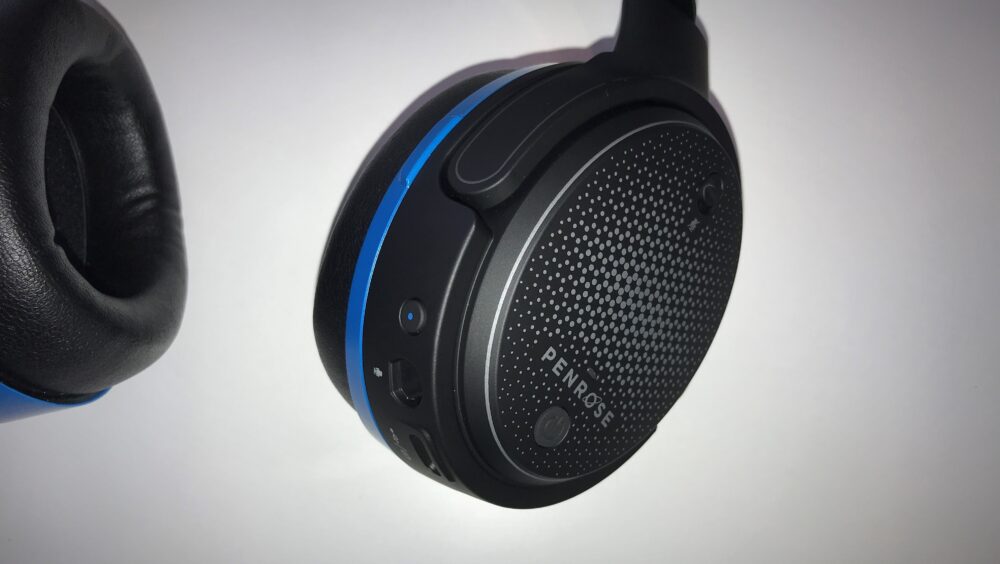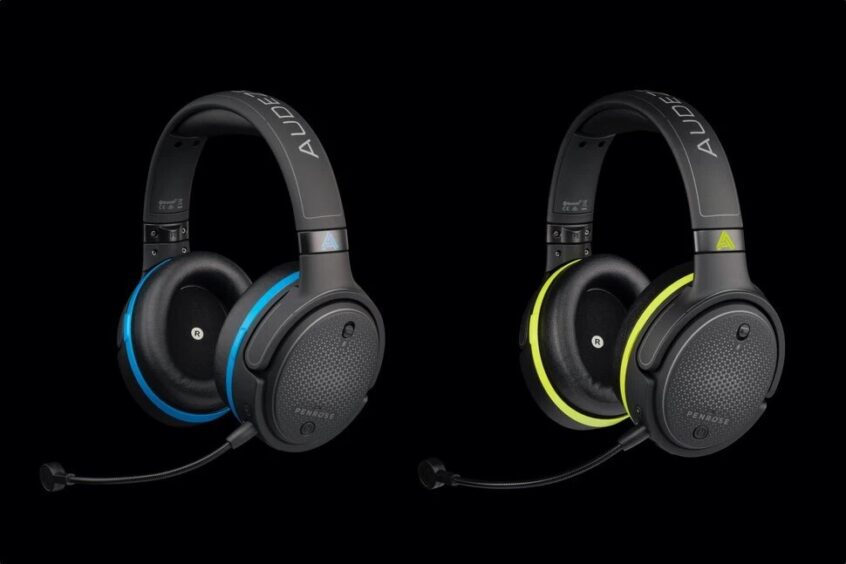I’ve spent two weeks using the Audeze Penrose headset for a ton of PlayStation and PC gaming – with a little work thrown in – and the results are just as impressive as they are expected. I previously had the opportunity to use Audeze’s Mobius headset and the Penrose shares many features when it comes to the build quality, audio reproduction, and microphone clarity. However, unlike the PC-focused Mobius, the Penrose is still an excellent choice if you’re looking for a headset that’ll cover your gaming, communication, and work needs on both console and PC. The option to connect using a 3.5 mm aux cable or Bluetooth is a bonus, but the 2.4GHz wireless adapter ensures you get the same excellent audio and microphone quality, wirelessly, on both platforms.
Unboxing
The Penrose shares the same quality packaging as the Mobius. Removing the inner box, you’ll find a quick-start guide and detailed instruction booklets. Below that, packed safely in a foam block, is the sturdy but flexible Penrose headset itself, and the 2.4Ghz wireless adapter. Below the foam block is a box with all the required cabling you’ll need, including USB-C to USB-C and USB-A to USB-C cables for charging, the 3.5 mm aux cable, and the detachable microphone. As with the Mobius, the microphone arm is flexible but strong, housed in a strong metallic sheath.

Specifications
Before discussing each component in detail, here is a brief overview of the specifications if you want to quickly compare the Penrose to other headsets:
- Style: Over-ear, closed-circumaural
- Transducer type: Planar Magnetic
- Magnetic structure: Fluxor magnet array
- Phase management: Fazor
- Magnet type: Neodymium N50
- Diaphragm type: Ultra-thin Uniforce
- Transducer size: 100 mm
- Maximum SPL: >120dB
- Frequency response: 10Hz – 50kHz
- THD: <0.1% (1 kHz, 1mW)
- Earpads: Contoured memory foam: artificial leather
- Microphone: Detachable with separate volume control
- Battery type: Lithium-polymer (15hr battery life, 3hr charge time)
- Wireless Connection: 2.4 GHz Wireless (16bit/48kHz) + Bluetooth
- Wired Connection: 3.5mm analog audio
- Weight: 320g (including battery)
What makes the Penrose special?
Unlike the Mobius, which incorporates onboard spatial audio processing and head tracking, the Penrose instead focuses on providing lossless, low-latency, wireless stereo audio. However, it still features the same excellent build quality and planar magnetic drivers. The over-ear cups are made of contoured memory foam, while the sturdy headband still allows enough flex for a comfortable fit on most heads. The cups can be adjusted for height and rotate up to 90 degrees backwards for storage.
Between the large drivers, over-ear cups, internal Lithium-polymer battery, and wireless processing components, the Penrose is heavy at 320g. As a result – and your tolerances may vary – I found them comfortable for 2-3 hours of continuous use before I increasingly felt the pressure of the headband. For those who get sweaty using over-ear cups, you may have to look for third-party pads as the memory foam, coupled with an artificial leather finish, do not make them very breathable.
When it comes to adjusting settings on the fly, all the ports and controls are on the left ear cup. At the bottom centre of the left cup, you’ll find the auxiliary 3.5 mm port and, moving towards the rear, are the separate volume wheels to adjust and balance the mic and audio levels. Towards the front, you’ll find the USB-C charging port and an asymmetrical port for the detachable mic. On the outer panel, you’ll find a combined power and Bluetooth pairing button towards the bottom (press-and-hold or tap quickly), and a mic mute toggle at the top. Unlike the Mobius, the power/Bluetooth button felt far more responsive when trying to trigger press and hold functions.

Moving onto the drivers themselves, these are Audeze’s patented planar magnetic transducers. A large electrostatic membrane, which generates sounds like a conventional dynamic driver, sits within a precisely arranged magnetic field. The modulation of that membrane induces a current in thin wires within the membrane, which is used to regulate the range of motion, ensuring clear waveforms. This unique design ensures fantastic audio reproduction, combining the basic function of cheaper dynamic drivers with that of the more expensive electrostatic drivers found in large speakers.
With a large 100 mm transducer, Neodymium N50 magnets, and an impressive frequency response range (10Hz – 50kHz), the Penrose sounds great and can tackle high volumes with ease. There’s also negligible total harmonic distortion (THD <0.1% @ 1 kHz, 1 mW). When it comes to the mic and voice clarity, the detachable microphone is up to the task. It fits easily into the asymmetrical 3.5 mm port, has a strong but flexible arm, and the independent volume controls and easy-to-access mute toggle work as expected. Based on feedback from online play and some recording tests, the mic picks up voice clearly and can handle loud volumes (up to 120 dB) with minimal distortion.
The 2.4Ghz adapter is sleek and stylish, but also slimmer and longer than most of its peers. Just make sure it’s not jutting out from your TV stand or desk, liable to be bumped or damaged. For PC and Android users, you can make use of the AudezeHQ application to further tailor the Penrose soundscape by tweaking the equalizer yourself, or selecting from several Audeze enhancements: profiles for music, specific gaming titles, or reworked Mobius gaming profiles for stereo.

The gaming experience
I put the Penrose headset through its paces while playing several of PlayStation’s big hits: The Last of Us Part II, Days Gone, God of War (and Apex Legends for some multiplayer chatting). To truly highlight the audio reproduction, and its impact on gameplay and immersion, I spent most of my time with the single-player games. All of them are games that place an incredible amount of emphasis on detailed environments, a rich soundscape, and brutal combat. I’ve had the opportunity to use several Sony headsets over the years, all of which usually offer great sound quality at the expense of build quality, but using the Penrose headset took the gaming experience to another level.
With so many gaming headsets focussed on reproducing low frequencies – the bass – it’s always remarkable to shift to a headset that perfectly reproduces low-, mid-, and high-frequencies. There’s a depth and richness to the soundscape that I imagine sound engineers spent ages perfecting, but very few of us get to appreciate fully. From the more cinematic firefights that pair on-screen action with a soaring soundtrack, to the quiet moments stealthing around, soaking in the ambience, and keeping an ear out for the distant steps of your foes, the Penrose always impressed. The wind howling through gulleys, trees creaking in the breeze, grass swaying, small animals and birds scurrying, the distant snarl of creatures – I discovered elements of the sound mix I never realised were there in the first place. If you game in a dark room, with the cups fitted snuggly for decent noise isolation, it’s easy to lose yourself in such an immersive soundscape that perfectly complements the visuals.
For those into competitive gaming, that same audio reproduction and mic clarity has advantages when keeping an ear out for an approaching team and conveying information to your teammates. This was particularly beneficial in the Apex Legends late-game, as multiple teams shuffled around the increasingly small zone and engaged in scrappy close-range gunfights. After swapping back and forth between several headsets, my teammates were uniformly impressed with the quality of the Penrose mic. As a bonus, the Penrose can be paired to both the 2.4GHz adapter and a Bluetooth connection simultaneously, if you would rather chat using another app like Discord on your phone/PC.
There is, however, one potential caveat for PlayStation 5 owners. The Penrose sits in the same price range as Sony’s premium headsets and is more expensive than their entry-level headsets, both of which supposedly maximise the impact of the patented 3D Spatial Audio technology. If quality spatial audio is your primary focus, you’ll need to weigh up the potential cost savings vs. the audio quality, build quality, and greater versatility offered by the Penrose.

The PC gaming, communication, and work experience
In line with the PlayStation experience, the Penrose offers excellent audio and mic quality when connected to a PC using the 2.4GHz adapter. For general communication and recording some narrated text, the wireless Penrose proved almost as good as their Mobius headset using a wired USB connection. There was minimal background noise in my recordings and my voice – deep and mumbling at the best of times – was recorded with perfect clarity.
Audeze claims the mic is “broadcast quality” and I’m inclined to believe them. As such, they should prove a good choice for those doing live streams or content creators looking to limit the amount of audio clean-up when preparing prerecorded podcasts and vlogs. The other benefit is that the fantastic sound reproduction that ensures you’re tweaking it for the best possible listening experience. With a battery life of around 15-hours – and 2-3 hours needed for a full charge – the Penrose covered me for 2-3 days of work and play.
Despite being a stereo headset, Windows 10 users can still make use of hardware-agnostic spatial audio with the Penrose, like Dolby Atmos or Windows Sonic (the Gears of War 4 and Gears 5 campaigns were my go-to test for this and sounded incredible).
Microphone quality tests
To give you a better feel for the mic quality, I recorded several lines using: a wired USB Mobius connection, the Penrose using the 2.4GHz connection, the Penrose using the 3.5mm aux cable, and the Penrose using a Bluetooth connection. The audio was captured using Audacity and exported directly to an MP3 file with no noise reduction pass.
Test 1: Audeze Mobius using a USB connection
Test 2: Audeze Penrose using the 2.4GHz connection
Test 3: Audeze Penrose using the 3.5mm aux connection
Test 4: Audeze Penrose using a Bluetooth connection
There’s decent functionality with other devices but Xbox owners should pick up the Penrose X instead.
With the ability to connect to other devices by 3.5 mm aux cable – such as last- or current-generation console gamepads – or Bluetooth, the Penrose is still a good choice if you’ve got multiple devices. However, the connection, audio, and mic quality are notably lower when not using the 2.4GHz wireless connection. You still get great audio reproduction, but I found the volume levels are lower and the mic background noise higher. The Penrose is also a powered headset and still needs to be charged to work over aux – a potential annoyance for those after a simple plug-and-play experience.
As a result, if you’re primarily an Xbox gamer, you should choose the Penrose X, which offers all the same features as the original Penrose. The 2.4GHz adapter has a toggle to switch between Xbox and PC, but the experience is otherwise identical – great audio reproduction, great mic quality, solid build quality. Additionally, with a focus on hardware-agnostic spatial surround sound, the Penrose X can take full advantage of DTS X, Dolby Atmos, and Windows Sonic.

Wrapping up
Overall, the Audeze Penrose is a great premium wireless headset for PlayStation and PC gamers, providing fantastic audio reproduction and excellent mic quality for communication and content creation. The planar magnetic drivers are unmatched, the build quality is solid, and the 2.4GHz wireless connection is crystal clear on both PS4/5 and PC. For Xbox (or Xbox and PC) gamers, pick up the Penrose X for wireless functionality and the same great feature set.
If you’ve only used budget headsets before, the Audeze Penrose headset will open your ears to a soundscape you may have never experienced or appreciated, enhancing immersion in single-player games and providing crisp communication and audio feedback in multiplayer titles. If you’re also live-streaming or recording podcasts, the clarity of the microphone, coupled with the high-end audio, ensures you’re tweaking your output to cover the best possible listening experience.
Ultimately, the quality matches the premium pricing, and these are an excellent alternative for PlayStation owners that want the quality sound of a Premium Sony headset but better build quality and greater versatility.
Grab your prefered headset here – https://www.audeze.com/products/penrose-wireless-planar-magnetic-headset
If you enjoy games and gaming and want more NEWS from the Gaming World Click Here








You must be logged in to post a comment.